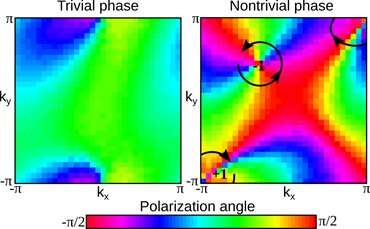Seeing stable topology using instabilities

We are most familiar with the four conventional phases of matter: solid, liquid, gas, and plasma. Changes between two phases, known as phase transitions, are marked by abrupt changes in material properties such as density. In recent decades a wide body of physics research has been devoted to discovering new unconventional phases of matter, which typically emerge at ultra-low temperatures or in specially-structured materials. Exotic "topological" phases exhibit properties that can only change in a quantized (stepwise) manner, making them intrinsically robust against impurities and defects.
In addition to topological states of matter, topological phases of light can emerge in certain optical systems such as photonic crystals and optical waveguide arrays. Topological states of light are of interest as they can form the basis for future energy-efficient light-based communication technologies such as lasers and integrated optical circuits.
However, at high intensities light can modify the properties of the underlying material. One example of such a phenomenon is the damage that the high-power lasers can inflict on the mirrors and lenses. This in turn affects the propagation of the light, forming a nonlinear feedback loop. Nonlinear optical effects are essential for the operation of certain devices such as lasers, but they can lead to the emergence of disorder from order in a process known as modulational instability, as is shown in Figure 1. Understanding the interplay between topology and nonlinearity is a fascinating subject of ongoing research.
Daniel Leykam, Aleksandra Maluckov, and Sergej Flach at the Center for Theoretical Physics of Complex Systems (PCS) within the Institute for Basic Science (IBS, South Korea), along with their colleagues Ekaterina Smolina and Daria Smirnova from the Institute of Applied Physics, Russian Academy of Sciences and the Australian National University, have proposed a novel method to characterize topological phases of light using nonlinear instabilities exhibited by bright beams of light. This research was published in Physical Review Letters.

In this work, the researchers addressed the fundamental question of how topological phases of light in nonlinear optical media undergo the process of modulational instability. It was shown theoretically that certain features of the instability, such as its growth rate, can differ between different topological phases. The researchers performed numerical simulations of the modulational instability and demonstrated that it can be used as a tool to identify different topological phases of light. An example of this idea is shown in Figure 2: While the light beams generated by the instability have seemingly-random patterns of intensity, they exhibit hidden order in their polarization in the form of robust vortices. The number of vortices appearing as a result of the instability is quantized, and they can be used to distinguish different topological phases.
The most common way to identify topological phases of light has been to look at the edges of the material, where certain optical wavelengths become localized. However, a complete characterization requires measuring the bulk properties of the material, which is a much harder task. The light in the bulk material undergoes complicated wave interference and is highly sensitive to defects, which obscures its topological properties. Counterintuitively, the researchers have shown how nonlinear instabilities may be used to tame this unwanted interference and spontaneously encode the bulk topological properties of the material into beams of light. This approach provides a simpler way to probe and perhaps even generate topological states of light.
The next step will be to test this proposal in an experiment. For example, optical waveguide arrays inscribed in a glass will be an ideal platform for this purpose. By shining a bright pulsed laser beam into the glass, it should be possible to directly observe the modulational instability and thereby measure the topological properties of the waveguide array. The research group is currently discussing possible designs for the experimental verification of their theory with collaborators.
More information: Daniel Leykam et al. Probing Band Topology Using Modulational Instability, Physical Review Letters (2021). DOI: 10.1103/PhysRevLett.126.073901
Journal information: Physical Review Letters
Provided by Institute for Basic Science



















